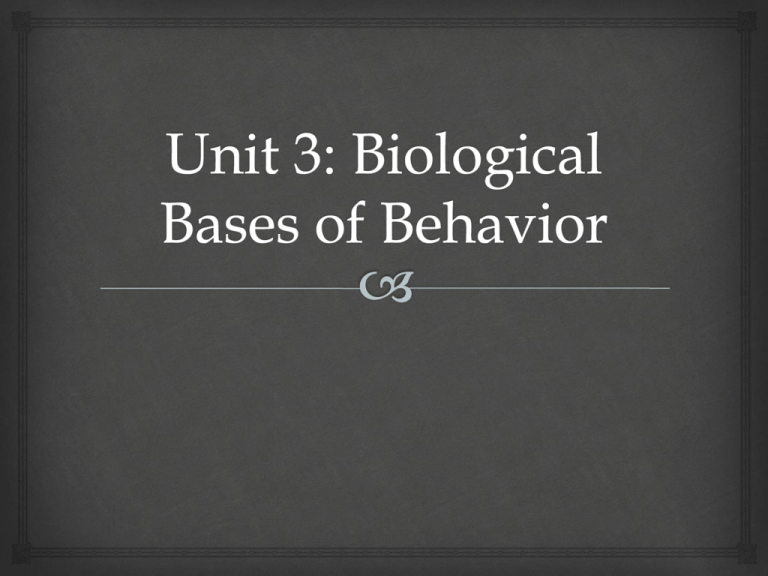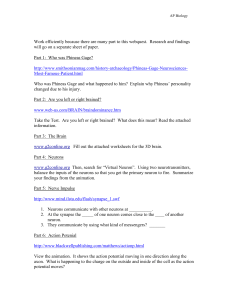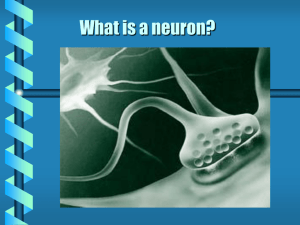
Biological Bases of
Behavior
Everything psychological is simultaneously _________
Every idea, mood, urge is a biological happening
Love, laugh, and cry with your body
Many people talk separately about biological and
psychological influences on behavior
“To think, feel, or act without a body would be like
running without legs”
Biological Psychologists
Biological Psychologists: branch of psychology
concerned with the links between _________ &
__________
Each system is composed of subsystems that are in
turn composed of even smaller subsystems
Structure and Communication
Neurons – What are they?
The basic building block of the
nervous system -- a nerve _____
Neurons perform three basic tasks
Receive
Carry
Pass on to the next
neuron
electrochemical
information
The brain is made up
of approximately
________
100
billion neurons.
Kinds of Neurons
Sensory Neurons (a.k.a. Afferent Neurons) carry incoming
information from the sense receptors to the CNS.
Motor Neurons (a.k.a. Efferent Neurons) carry outgoing
information from the CNS to muscles and glands.
Interneurons connect the two neurons.
Sensory Neuron
Interneuron Neuron
Motor Neuron
•
Sensory neurons take info. from the senses to the brain.
• Interneurons take messages from sensory neurons to other parts of the brain or to motor
neurons.
• Motor neurons take info. from the brain to the rest of the body.
Structure of a Neuron
Structure of a Neuron –
Dendrites
Structure of a Neuron –
Soma
Structure of a Neuron –
Axon
Structure of a Neuron –
Neural Impulse
Structure of a Neuron –
Myelin Sheath
Structure of a Neuron –
Terminals
Neurons come in a variety of shapes and sizes, but they
all have the same basic structure
Neurons – magnified
view
Neuron – another view
Neurons – How do they
work?
Neurons send messages to other neurons – this is what
keeps every part of our body in communication with every
other part.
Neurons “fire” – send an impulse (message) down their
length – or they don’t “fire”
http://brainu.org/files/movies
/action_potential_cartoon.swf
Action Potentials
This “firing” of impulse messages is called the action
potential.
Action potential: is a brief electrical charge that
travels down the axon of the neuron.
What causes an impulse to
fire or not fire?
Resting Potential: when a neuron is at rest
and capable of generating an action potential
There are fluids inside and outside of the neuron,
filled with electrically charged particles (ions)
When the neuron is at rest, there is a negative charge on
the inside of the neuron compared to the outside.
Action Potentials, cont.
Stimulation from inputs to dendrites causes the
cell membrane to open briefly
Positively charged sodium ions flow in through
the cell membrane
If resting potential rises above threshold, an
action potential starts to travel from the cell body
down the axon
Threshold - Each neuron receives excitatory and
inhibitory signals from many neurons.
When the excitatory signals minus the inhibitory signals
exceed a minimum intensity (threshold) the neuron fires an
action potential.
Action Potential, cont.
Refractory period - The “recharging phase” when a
neuron, after firing, cannot generate another action
potential
Neuron Communication
All-or-None Principle: if a
neuron fires it will always fire at
the same intensity
A strong stimulus can trigger more
neurons to fire, and to fire more often,
but all action potentials are of the
same strength and speed.
A neuron does NOT fire at 30%,
45% or 90% but at 100% each time it
fires.
Just like a gun, there
is no “part-way” firing
Action Potential
PowerPoint® 2000 or better with Flash® plug-in required to view animations.
Right-click on animation for playback controls.
Instructor’s Notes
Copyright © Houghton Mifflin Company. All rights reserved.
So what, exactly, are
neurotransmitters and
what do they do?
Neurotransmitters
Neurotransmitters: chemical messenger
that travels across the synapse from one
neuron to the next
Can influence whether the second
neuron will generate an action potential
or not
Select Neurotransmitters
Neurotransmitter
Acetylcholine (ACh)
Dopamine (DA)
Function
Released by motor neurons
controlling skeletal muscles.
Enables muscle action,
attention, arousal, and
memory
Influences voluntary
movement, learning,
attention, and
pleasurable emotions
Affects mood, hunger,
sleep, and arousal
Examples
•
•
•
•
•
Serotonin
•
With Alzheimer’s
disease, ACh-producing
neurons deteriorate.
Some ACh receptors
stimulated by nicotine.
Excess dopamine
receptor activity linked
to schizophrenia.
Decreased levels
produce the decreased
mobility and tremors of
Parkinson’s disease.
Undersupply linked to
depression and
obsessive-compulsive
disorder.
Prozac and some other
antidepressant drugs
raise serotonin levels.
•
How Neurotransmitters Influence
Us
Serotonin
•
pathways are
involved
with mood
regulation.
Dopamine
pathways are
involved with
diseases such as:
•
Schizophrenia
(too much DA)
•
Parkinson’s
disease (not
enough DA).
Select Neurotransmitters (cont.)
Neurotransmitter
Function
Examples
Norepinephrine (NE)
Helps control alertness,
mood, and arousal
Undersupply can depress
mood.
A major inhibitory
neurotransmitter
Undersupply linked to
seizures, tremors, and
insomnia.
Endorphins
Contribute to pain relief
and perhaps to some
pleasurable emotions
(“Runner’s High”)
Resemble opiate drugs
in structure and effects
Glutamate
A major excitatory
neurotransmitter; involved
in memory
Oversupply can
overstimulate brain,
producing migraines or
seizures (which is why
some people avoid MSG,
monosodium glutamate, in
food)
GABA (gammaaminobutyric acid)









